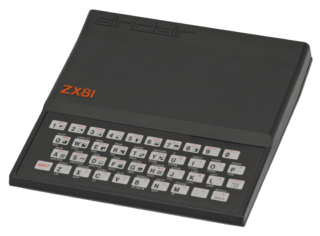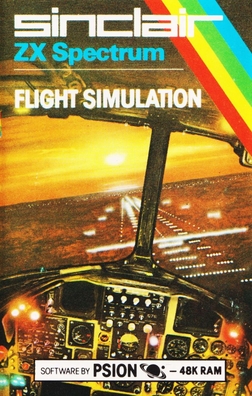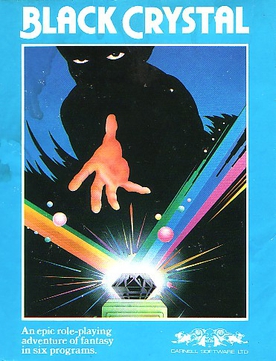| 1K ZX Chess | |
|---|---|
 Box cover | |
| Designer(s) | David Horne |
| Platform(s) | Sinclair ZX81 |
| Release | 1982 [1] |
| Genre(s) | Abstract strategy |
| Mode(s) | Single-player |
1K ZX Chess is a 1982 chess program for the unexpanded Sinclair ZX81.
| 1K ZX Chess | |
|---|---|
 Box cover | |
| Designer(s) | David Horne |
| Platform(s) | Sinclair ZX81 |
| Release | 1982 [1] |
| Genre(s) | Abstract strategy |
| Mode(s) | Single-player |
1K ZX Chess is a 1982 chess program for the unexpanded Sinclair ZX81.
1K ZX Chess's code takes up only 672 bytes in memory, [2] but implements chess rules except for castling, promotion, and en passant, including a computer opponent. [3] It was the smallest implementation of chess on any computer at the time. Developer David Horne discussed 1K ZX Chess and published the full source code as a type-in program in a series of articles in Your Computer in 1982 and 1983. [4] [5] [2]
Popular Computing Weekly in 1982 called 1K ZX Chess "one of the most interesting ZX tapes to pass through our office in recent weeks". It approved of the computer displaying moves while considering them and noted "the skills which went into writing a chess program in 1K of machine code. Is there anyone reading this who could even contemplate doing the same?" The magazine concluded, "Despite the limitations this is one cassette, at £3, which I would recommend." [6] Sinclair User in 1983 stated that "it takes some technical wizardry to squeeze this kind of game into the unexpanded ZX81". The magazine praised the game's quick loading speed, and found that it "makes its moves very fast for the amount of memory available for it". [3] Home Computing Weekly gave the game three out of five stars, criticizing the confusing user interface but stating that "it still produces play which needs some thought to beat". [7] Tim Harding wrote in a 1985 book on computer chess that "the man who did it must be some sort of genius". While describing 1K ZX Chess' quality of play as "so appalling that it would be hard to make it beat you" and criticizing the backward algebraic notation, he concluded that "the program is nevertheless a fantastic technical achievement". [8]
1K ZX Chess came in second place for best software in a poll of ZX81 users. Retrogaming Times Monthly described it as "history's greatest game programming feat"; [9] Kuro5hin agreed, calling 1K ZX Chess "the greatest program ever written". BootChess author Olivier Poudade praised 1K ZX Chess's code, stating that at first writing a smaller chess program "seemed impossible ... Horne had nailed it so much already". Poudade acknowledged replicating some of Horne's methods as he could not improve them. [1]

The Jupiter Ace by Jupiter Cantab was a British home computer released in 1982. The Ace differed from other microcomputers of the time in that its programming environment used Forth instead of the more popular BASIC. This difference, along with limited available software and poor character based graphic display, limited sales and the machine was not a success.

The Sinclair ZX80 is a home computer launched on 29 January 1980 by Science of Cambridge Ltd.. It is notable for being one of the first computers available in the United Kingdom for less than a hundred pounds. It was available in kit form for £79.95, where purchasers had to assemble and solder it together, and as a ready-built version at £99.95.

The ZX Spectrum is an 8-bit home computer developed and marketed by Sinclair Research. Considered one of the most influential computers ever made, it is also one of the best-selling British computers ever, with over five million units sold. It was released in the United Kingdom on 23 April 1982, and around the world in the following years, most notably in Europe, the United States, and Eastern Bloc countries.

The ZX81 is a home computer that was produced by Sinclair Research and manufactured in Dundee, Scotland, by Timex Corporation. It was launched in the United Kingdom in March 1981 as the successor to Sinclair's ZX80 and designed to be a low-cost introduction to home computing for the general public. It was hugely successful; more than 1.5 million units were sold. In the United States it was initially sold as the ZX-81 under licence by Timex. Timex later produced its own versions of the ZX81: the Timex Sinclair 1000 and Timex Sinclair 1500. Unauthorized ZX81 clones were produced in several countries.
Sinclair BASIC is a dialect of the programming language BASIC used in the 8-bit home computers from Sinclair Research, Timex Sinclair and Amstrad. The Sinclair BASIC interpreter was written by Nine Tiles Networks Ltd.
Sinclair Research Ltd was a British consumer electronics company founded by Clive Sinclair in Cambridge. It was originally incorporated in 1973 as Westminster Mail Order Ltd, renamed Sinclair Instrument Ltd, then Science of Cambridge Ltd, then Sinclair Computers Ltd, and finally Sinclair Research Ltd. It remained dormant until 1976, when it was activated with the intention of continuing Sinclair's commercial work from his earlier company Sinclair Radionics, and adopted the name Sinclair Research in 1981.

3D Monster Maze is a survival horror computer game developed from an idea by J.K. Greye and programmed by Malcolm Evans and released in 1981 for the Sinclair ZX81 platform with the 16 KB memory expansion. The game was initially released by J. K. Greye Software in December 1981 and re-released in 1982 by Evans' own startup, New Generation Software. Rendered using low-resolution character block "graphics", it was one of the first 3D games for a home computer, and one of the first games incorporating typical elements of the genre that would later be termed survival horror.

Artic Computing was a software development company based in Brandesburton, England from 1980 to 1986. The company's first games were for the Sinclair ZX81 home computer, but they expanded and were also responsible for various ZX Spectrum, Commodore 64, BBC Micro, Acorn Electron and Amstrad CPC computer games. The company was set up by Richard Turner and Chris Thornton. Charles Cecil, who later founded Revolution Software, joined the company shortly after it was founded, writing Adventures B through D. Developer Jon Ritman produced a number of ZX81 and Spectrum games for Artic before moving to Ocean Software.

Bug-Byte Software Ltd. was a video game company founded in 1980 in Liverpool, initially producing software for the Acorn Atom and ZX80. Bug-Byte's first hit was Don Priestley's Mazogs which was one of the most successful titles for the ZX81. In 1983, it published Manic Miner, considered to be one of the most influential platform games of all time. The company went into liquidation in 1985 but their name and logo were purchased by Argus Press PLC for use as a budget software label.
J.K. Greye Software was a British software company set up by J.K. Greye in early 1981 and 6 months later joined by Malcolm Evans after they met at a Bath Classical Guitar & Lute Society meeting in Bath in 1981. They produced computer games for the Sinclair ZX81 and ZX Spectrum home computers.
Quicksilva was a British games software publisher active during the early 1980s.
Crystal Computing, later renamed Design Design, was a British video game developer founded in 1982 by Chris Clarke and Ian Stamp while students at the University of Manchester. Graham Stafford, Neil Mottershead, Simon Brattel and Martin Horsley, joined the company as it expanded. The company's first software release was a compilation of games for the Sinclair ZX81, though it was with the ZX Spectrum that Crystal found its greatest success. A deal with the machine's manufacturer Sinclair to distribute Crystal's Zeus Assembler gave the company sufficient funds for a major marketing campaign for their next product, Halls of the Things, an arcade adventure game that became their most successful title.
Don Priestley is a teacher and former video game programmer who wrote over 20 commercial games for the ZX81 and ZX Spectrum home computers between 1982 and 1989. Despite successful releases for DK'Tronics, such as 3D Tanx and Maziacs, Priestley returned to teaching in the late 1980s, claiming changes in the video game industry did not suit his style of work.

The Lambda 8300 was a Sinclair ZX81 clone from Lambda Electronics Limited of Hong Kong. It had a modified ROM and extra hardware, making it not fully compatible. Total compatibility could be achieved by installing a ZX81 ROM.
Richard Francis Altwasser is a British engineer and inventor, responsible for the hardware design of the ZX Spectrum.

Flight Simulation is a flight simulation program written by Psion and marketed by Sinclair Research for the ZX Spectrum and ZX81 home computers.

Mined-Out is a maze video game created by Ian Andrew originally for the ZX Spectrum home computer in 1983. The objective is to carefully navigate a series of grid-shaped minefields by moving from the bottom to the top of the screen. The number of invisible mines in spaces adjacent to the player's current position is shown but not their precise location, requiring deduction to advance past them and avoid getting blown up. Additional challenges are introduced in later stages.

Volcanic Dungeon is a role-playing video game designed by Roy Carnell and Stuart A. Galloway and released by Carnell Software for the ZX Spectrum, Dragon 32/64 and ZX81 computers in 1983. It is a follow-up to 1982's Black Crystal.

Black Crystal is an action-adventure game released in 1982 for the ZX81, ZX Spectrum, Commodore 64 and TI-99/4A computers by Carnell Software Ltd. It was the first in the "Third Continent Trilogy" of adventure games; followed by Volcanic Dungeon and The Wrath of Magra.
In mid-1982, a small quarter-page advert appeared in a computer hobbyist magazine. For just £5 (about US$26.50 today), the ad's pixelated block text promised a computer chess program with "absolutely flicker-free display" and an opponent who would make its move on average just six seconds after yours. "Sensational 1K ZX 81 Chess," claimed the copy, and ignoring that today-inexplicable numerical assemblage, the important points are "sensational" and "chess."